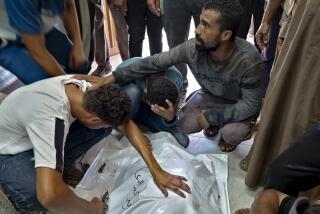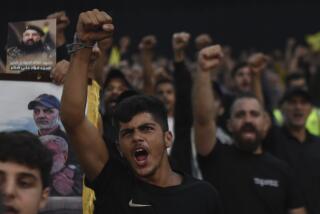Kerry says Syria is close to a ceasefire, but bombings claim dozens of lives
A wave of suicide bombings killed dozens of people in government-controlled areas of the Syrian capital, Damascus, and the city of Homs on Sunday, even as U.S. Secretary of State John Kerry insisted the parties were closer to a ceasefire than ever before.
The state-run Syrian Arab News Agency reported that a pair of car bombs exploded at a public transport station in the Zahraa neighborhood of Homs on Sunday morning, killing at least 46 people and wounding more than 100, in what pro-government media said was the 20th suicide attack on the district since the beginning of the Syrian uprising in 2011.
Photos taken in the immediate aftermath of the blast showed charred husks of cars and minivans in the middle of a debris-strewn thoroughfare, as emergency crews scrambled to take the wounded to nearby hospitals.
Other pro-government outlets and activists on social media said the bombings occurred in a coordinated fashion, with one parked vehicle detonating as a truck carrying the other suicide bomber was passing through the area. They also put the death toll at more than 100.
Islamic State claimed responsibility for the bombings in a statement on social media on Sunday, crediting “two knights of martyrdom” with targeting “Nusayris,” a pejorative name for the Alawite sect, an offshoot of Shia Islam whose members include Syrian President Bashar Assad. It claimed it had killed 90 people and wounded more than 150.
The Sunni Muslim extremist group, which adheres to a strict reading of Islamic law, views Alawites and Shiites as apostates to be killed.
Later on Sunday, at least 31 people were killed when Islamic State jihadists launched multiple attacks near the Sayedah Zeinab suburb, 10 miles southeast of Damascus.
A statement by Islamic State, however, said more than 90 were killed and approximately 160 were wounded in the blasts when two suicide bombers struck a vegetable market near the Sayedah Zeinab mosque, an important Shiite shrine commemorating the daughter of the Prophet Mohammad.
The area, a frequent target of the Sunni-dominated insurgency (in January a triple bombing by Islamic State killed some 60 people) is heavily secured by Shiite militias allied to the Assad government.
A pro-government Sayedah Zeinab Facebook community page reported all entrances to the shrine were closed in the wake of the onslaught.
The Syrian conflict, which is about to enter its sixth year, has killed more than 250,000 people and left large swaths of the country ravaged by the fighting. It has also spurred a large refugee crisis that has reached Europe’s shores and created fissures among the nations of the European Union.
Although it began as a series of largely peaceful anti-government protests, the crisis soon devolved into a sectarian bloodbath that has pitted the country’s minority Alawites, Shiites and Christians against Sunni-dominated armed rebel factions.
The attacks come as Kerry gave a stubbornly optimistic reading of a ceasefire taking hold in the war-ravaged country in a press conference in the Jordanian capital, Amman. His comments followed a telephone conversation with his Russian counterpart, Foreign Minister Sergei Lavrov.
Kerry said the mechanics of a cease-fire “are now being completed. In fact, we are [closer] to a ceasefire today than we have been.”
“And I take nothing for granted about this. A cessation of hostilities, a hudna [the Arabic word for truce], is possible over the course of these next hours.”
Earlier in February, the International Syria Support Group, a group of 17 nations working to enact a political transition in Syria and end the fighting, said its members would use their influence with the fighting parties to enforce a ceasefire. The group includes the United States, which wants Assad’s removal from power, as well as Assad patrons Russia and Iran.
The ceasefire, however, would not include groups designated as terrorist organizations, including the Al Qaeda-affiliated Nusra Front and the Islamic State.
However, the Friday deadline for a “cessation of hostilities” passed with no letup in the fighting, as pro-government forces backed by Russian airstrikes drove rebels out of key areas along the Syrian-Turkish border, the opposition’s main lifeline.
The government is now poised to take back rebel-held parts of the city of Aleppo, where its troops have fought to dislodge the opposition since 2012.
A statement by the Russian Foreign Ministry on Sunday said the diplomats had “discussed issues of the current practical interaction between Russia and the United States,” including the coordination of the cease-fire, “except for the fight against terrorist groups.”
Russia deployed aircraft and special forces units in support of the Syrian government in September in what it claimed was an air campaign against the Islamic State. Its attacks, however, have focused on the so-called moderate opposition, which includes factions supported by the C.I.A. and the Pentagon.
Kerry reiterated that the United States plans to “put in place a political transition that finds a government responsive to the desperate needs of the Syrian people.”
“And, my friends, that is a government that cannot possibly have Assad at its head. That is why we have said again and again that with Assad there this war cannot and will not end,” said Kerry.
Assad’s fate has been a major hurdle in negotiations. The Syrian government and its allies contend there can be no pre-conditions regarding the country’s leadership. The opposition, however, insists Assad cannot be a part of any transitional government.
Bulos is a special correspondent
More to Read
Sign up for Essential California
The most important California stories and recommendations in your inbox every morning.
You may occasionally receive promotional content from the Los Angeles Times.











